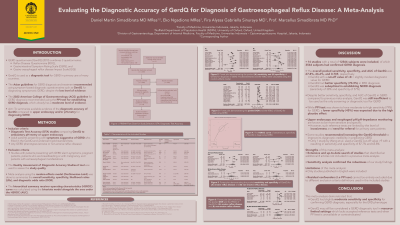Back


Poster Session A - Sunday Afternoon
Category: Esophagus
A0181 - Evaluating the Diagnostic Accuracy of GerdQ for Diagnosis of Gastroesophageal Reflux Disease: A Meta-Analysis
Sunday, October 23, 2022
5:00 PM – 7:00 PM ET
Location: Crown Ballroom

Has Audio

Daniel M. Simadibrata, MD
Universitas Indonesia
Jakarta Pusat, Jakarta Raya, Indonesia
Presenting Author(s)
Daniel M. Simadibrata, MD1, Eko Ngadiono, 1, Fira A. Sinuraya, MD1, Marcellus Simadibrata, MD, PhD2
1Universitas Indonesia, Jakarta Pusat, Jakarta Raya, Indonesia; 2Universitas Indonesia – Ciptomangunkusumo Hospital, Jakarta Pusat, Jakarta Raya, Indonesia
Introduction: Establishing an accurate diagnosis of GERD is challenging, especially in resource-limited settings lacking accepted reference tests such as upper endoscopy and ambulatory pH-metry. Furthermore, guideline recommendations regarding using symptom-based GERD questionnaires were inconsistent, highlighting the lack of evidence available for such questionnaires. This meta-analysis aims to assess the diagnostic accuracy of GerdQ in comparison to upper endoscopy and/or pH-metry for establishing GERD diagnosis.
Methods: Studies published up to April 18, 2022, and indexed in Ovid MEDLINE, Ovid EMBASE, SCOPUS, Web of Science, and the Cochrane Library were searched. Diagnostic test accuracy (DTA) studies comparing GerdQ to an accepted reference test (upper endoscopy and/or pH-metry) for GERD diagnosis in adult patients with symptoms suggestive of GERD were eligible for inclusion. The quality of studies was assessed using the Quality Assessment of Diagnostic Accuracy Studies-2 (QUADAS-2) tool. Meta-analysis using the random-effects model (DerSimonian-Laird) was done to calculate the overall sensitivity, specificity, likelihood ratios (LRs), and the diagnostic odds ratio (DOR). The hierarchical summary receiver operating characteristics (HSROC) curve was calculated using the bivariate model with the area under the receiver operating characteristic curve (AUC).
Results: A total of 14 studies with 12566 participants were analyzed in this meta-analysis. The pooled estimates of sensitivity, specificity, positive LR, negative LR, and DOR for GerdQ (cut-off value of ≥8) were 67.8% (95%CI 57.1%-76.9%), 66.6% (95%CI 57.7%-74.4%), 1.83 (95% 1.49-2.24), 0.55 (95%CI 0.46-0.67), and 3.79 (95%CI 2.36-6.08), respectively. The HSROC curve showed an overall AUC of 0.705. The subgroup analysis based on Asian and non-Asian studies showed similar pooled sensitivity, specificity, and DOR.
Discussion: GerdQ had moderate sensitivity and specificity for establishing GERD diagnosis. GerdQ could still be recommended as a diagnostic tool for GERD only when the PPI test is unavailable or contraindicated.
Disclosures:
Daniel M. Simadibrata, MD1, Eko Ngadiono, 1, Fira A. Sinuraya, MD1, Marcellus Simadibrata, MD, PhD2. A0181 - Evaluating the Diagnostic Accuracy of GerdQ for Diagnosis of Gastroesophageal Reflux Disease: A Meta-Analysis, ACG 2022 Annual Scientific Meeting Abstracts. Charlotte, NC: American College of Gastroenterology.
1Universitas Indonesia, Jakarta Pusat, Jakarta Raya, Indonesia; 2Universitas Indonesia – Ciptomangunkusumo Hospital, Jakarta Pusat, Jakarta Raya, Indonesia
Introduction: Establishing an accurate diagnosis of GERD is challenging, especially in resource-limited settings lacking accepted reference tests such as upper endoscopy and ambulatory pH-metry. Furthermore, guideline recommendations regarding using symptom-based GERD questionnaires were inconsistent, highlighting the lack of evidence available for such questionnaires. This meta-analysis aims to assess the diagnostic accuracy of GerdQ in comparison to upper endoscopy and/or pH-metry for establishing GERD diagnosis.
Methods: Studies published up to April 18, 2022, and indexed in Ovid MEDLINE, Ovid EMBASE, SCOPUS, Web of Science, and the Cochrane Library were searched. Diagnostic test accuracy (DTA) studies comparing GerdQ to an accepted reference test (upper endoscopy and/or pH-metry) for GERD diagnosis in adult patients with symptoms suggestive of GERD were eligible for inclusion. The quality of studies was assessed using the Quality Assessment of Diagnostic Accuracy Studies-2 (QUADAS-2) tool. Meta-analysis using the random-effects model (DerSimonian-Laird) was done to calculate the overall sensitivity, specificity, likelihood ratios (LRs), and the diagnostic odds ratio (DOR). The hierarchical summary receiver operating characteristics (HSROC) curve was calculated using the bivariate model with the area under the receiver operating characteristic curve (AUC).
Results: A total of 14 studies with 12566 participants were analyzed in this meta-analysis. The pooled estimates of sensitivity, specificity, positive LR, negative LR, and DOR for GerdQ (cut-off value of ≥8) were 67.8% (95%CI 57.1%-76.9%), 66.6% (95%CI 57.7%-74.4%), 1.83 (95% 1.49-2.24), 0.55 (95%CI 0.46-0.67), and 3.79 (95%CI 2.36-6.08), respectively. The HSROC curve showed an overall AUC of 0.705. The subgroup analysis based on Asian and non-Asian studies showed similar pooled sensitivity, specificity, and DOR.
Discussion: GerdQ had moderate sensitivity and specificity for establishing GERD diagnosis. GerdQ could still be recommended as a diagnostic tool for GERD only when the PPI test is unavailable or contraindicated.
Disclosures:
Daniel Simadibrata indicated no relevant financial relationships.
Eko Ngadiono indicated no relevant financial relationships.
Fira Sinuraya indicated no relevant financial relationships.
Marcellus Simadibrata indicated no relevant financial relationships.
Daniel M. Simadibrata, MD1, Eko Ngadiono, 1, Fira A. Sinuraya, MD1, Marcellus Simadibrata, MD, PhD2. A0181 - Evaluating the Diagnostic Accuracy of GerdQ for Diagnosis of Gastroesophageal Reflux Disease: A Meta-Analysis, ACG 2022 Annual Scientific Meeting Abstracts. Charlotte, NC: American College of Gastroenterology.
